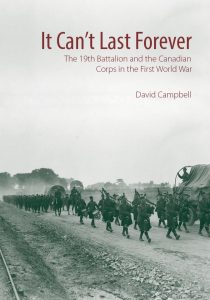Take the story of one battalion raised in one city, multiply it 100,000 times, and you have a haunting account of the catastrophe of the First World War. Historian David Campbell chronicles such a story with encyclopedic research and a filmmaker’s eye for poignant detail, like the Battle of Passchendaele reduced to a terrified pack mule drowning in mud.
“The more we pulled on him the worse it was, and the poor thing kept sinking down and down, inch by inch, and we were frantic. We couldn’t stop it and finally the transport officer of the 18th Battalion decided there was only one thing to do…When his head was just above the mud the officer had pulled his revolver out of his holster, and the mule turned his head, and I will never forget the look on that poor brute’s great big brown eyes when he looked at the officer, and the officer shot him, and then cried like a kid. Some of us, too.”
It Can’t Last Forever chronicles the life and death of the 19th Battalion of Hamilton, Ont., raised in 1914 and disbanded in 1920. The Battalion saw action from the 1916 Battle of Ypres – the troops called it “Wipers” – to the last day of the war on November 10, 1918. Campbell tells their story by the numbers: 3,076 casualties; 264 cases of venereal disease; 18 Battle Honours; eight recipients of the Distinguished Service Order; five commanding officers; and one soldier executed for desertion, Private Harold Lodge, 20, who left a heartbroken mother on Dunne Avenue.
Volunteers with the 19th were mainly single, English-born, at least 5 foot 3, without any military training. Many were happy to get regular meals and a private’s pay, $1.10 a day. When they left Hamilton in 1914, the town band played Tipperary as the train pulled out of the station. The first commanding officer was John McLaren, a former Hamilton mayor who tried to jolly weary soldiers on a 17-mile march by remarking, “Only 500 yards further, boys.”
It Can’t Last Forever documents the lives of these boy soldiers as they became survivors, then ruthless combat veterans. By the Battle of Amiens in 1918, infantrymen would shoot German prisoners rather than send them back of the lines. “My nerves are gone,” wrote one veteran; “The war has made me ten years older.”
Combat life was comprised of monotonous food – soldiers ate a lot of plum and apple jam in WWI – and long periods of tedium interspersed with outbreaks of terror. The enemy were called “Heinies,” German mortar rounds were nicknamed “flying pigs.” Soldiers cursed their five-pound hobnail boots and Canadian-made Ross rifles that jammed in combat, and learned that death was random. “Two chaps behind me were blown to pieces,” recalled a soldier at the Battalion’s first action. “It was a horrible place.”
The first infantryman killed in action with the 19th was George Durand, 21, a machinist, shot in the head by a German sniper. The oldest member lived to 106. One veteran, Ed Youngman, remembered the bravest man in his unit, a small, meek fellow the Battalion cruelly nicknamed Lizzie.
At the Battle of Vimy, Youngman recalled he was trying to quiet a panicked mule under heavy shellfire as one by one, other mule drivers passed him pale with fright. Then along came Lizzie, “the butt of all our jokes,” he wrote: “He was the only little fellow who had the guts to say, ‘Can I help you, Eddie?’ He held the mule and his own. I don’t know how he did it”. “For me, he was one of the bravest men who ever lived.”
It Can’t Last Forever is a tragic and beautiful book.
By Holly Doan
It Can’t Last Forever: The 19th Battalion and the Canadian Corps in the First World War, by David Campbell; Wilfrid Laurier University Press; 680 pages; ISBN 0781-7711-22368; $39.99









